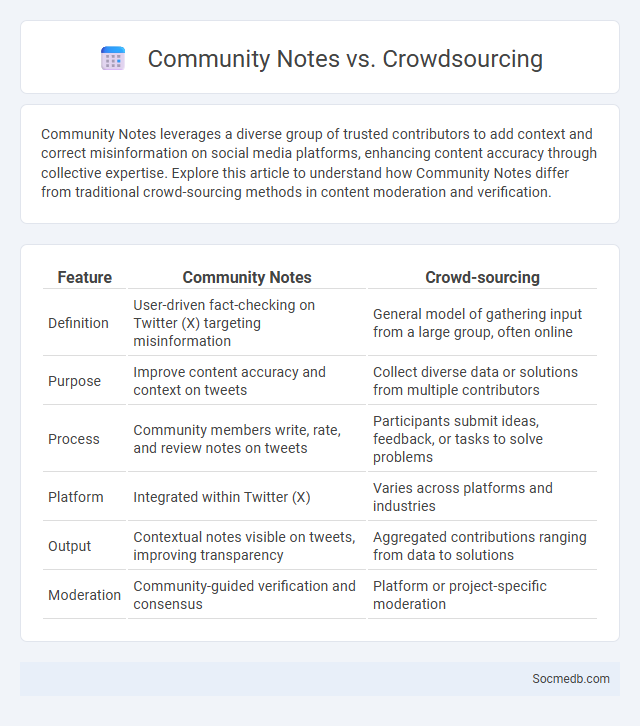
Photo illustration: Community Notes vs Crowd-sourcing
Community Notes leverages a diverse group of trusted contributors to add context and correct misinformation on social media platforms, enhancing content accuracy through collective expertise. Explore this article to understand how Community Notes differ from traditional crowd-sourcing methods in content moderation and verification.
Table of Comparison
| Feature | Community Notes | Crowd-sourcing |
|---|---|---|
| Definition | User-driven fact-checking on Twitter (X) targeting misinformation | General model of gathering input from a large group, often online |
| Purpose | Improve content accuracy and context on tweets | Collect diverse data or solutions from multiple contributors |
| Process | Community members write, rate, and review notes on tweets | Participants submit ideas, feedback, or tasks to solve problems |
| Platform | Integrated within Twitter (X) | Varies across platforms and industries |
| Output | Contextual notes visible on tweets, improving transparency | Aggregated contributions ranging from data to solutions |
| Moderation | Community-guided verification and consensus | Platform or project-specific moderation |
Understanding Community Notes: Definition and Purpose
Community Notes are collaborative annotations on social media platforms designed to provide context and verify the accuracy of posts. They aim to combat misinformation by enabling users to add relevant, fact-based information directly to content, enhancing transparency and trust. This system leverages collective intelligence to improve the quality of information circulating on social networks.
What is Crowd-sourcing? Key Concepts and Applications
Crowd-sourcing leverages the collective intelligence of a large group of people, often via social media platforms, to gather ideas, services, or content. Key concepts include open collaboration, distributed problem-solving, and harnessing diverse expertise to improve innovation and efficiency. Applications range from product development and market research to crisis response and content creation, demonstrating its transformative impact on business and society.
Community Notes vs Crowd-sourcing: Core Differences
Community Notes leverages a diverse group of trusted contributors to add context and fact-check information directly on social media platforms, improving content transparency and accuracy. Crowd-sourcing typically involves gathering data or insights from a large, undefined population to achieve broad participation but may lack stringent vetting processes. Understanding these core differences can help you choose the most reliable and effective method for verifying and enhancing social media content.
How Community Notes Enhance Information Accuracy
Community Notes empower users to collaboratively identify and correct misinformation across social media platforms, leveraging diverse perspectives for improved fact-checking. By allowing contributors to add context and verified information to misleading posts, these notes foster transparency and build trust among audiences. The collective intelligence behind Community Notes significantly enhances information accuracy, reducing the spread of false content.
The Role of Crowd-sourcing in Collaborative Content Creation
Crowd-sourcing plays a pivotal role in collaborative content creation on social media by enabling diverse users to contribute ideas, feedback, and creative inputs that elevate the quality and relevance of shared content. Platforms like Instagram, TikTok, and Reddit harness the collective intelligence of millions, allowing your content to be shaped by community-driven insights and trends. Leveraging crowd-sourced contributions enhances engagement, fosters innovation, and drives authentic interactions within your social media network.
Pros and Cons of Community Notes Systems
Community Notes systems enhance social media by enabling users to collaboratively fact-check content, improving information accuracy and reducing misinformation spread. However, these systems can face challenges like bias, inconsistent moderation quality, and potential delays in addressing rapidly evolving news. Your engagement in Community Notes can help maintain a balanced and trustworthy social media environment.
Strengths and Limitations of Crowd-sourcing Approaches
Crowd-sourcing in social media leverages diverse user-generated content to enhance creativity, problem-solving, and information dissemination at scale, enabling real-time feedback and innovation. Strengths include rapid data aggregation, cost-effectiveness, and access to a broad range of perspectives and expertise. Limitations encompass quality control challenges, potential bias from non-representative participant groups, and risks related to misinformation or lack of accountability.
Case Studies: Successful Community Notes Initiatives
Case studies of successful Community Notes initiatives demonstrate how platforms like Twitter and Facebook enhance content accuracy by leveraging user contributions to fact-check and provide context. These initiatives increase user trust and engagement by promoting transparent information sharing and minimizing misinformation spread. Your participation in Community Notes can empower communities to maintain a reliable and informative social media environment.
When to Choose Community Notes Over Crowd-sourcing
Community Notes are preferred over traditional crowd-sourcing when accurate, context-rich insights from a diverse group of vetted contributors are essential for content credibility on social media platforms. This approach leverages real-time fact-checking and collaborative annotations to reduce misinformation effectively, enhancing user trust and engagement. Opting for Community Notes ensures nuanced moderation while balancing scalability and quality control in digital discussions.
Future Trends: Evolving Models in Community Verification
Emerging social media platforms are adopting decentralized verification models that leverage blockchain technology to enhance user authenticity and reduce misinformation. AI-driven algorithms are evolving to validate communities by analyzing interaction patterns and content credibility, fostering safer digital environments. Privacy-centric verification methods are gaining traction, allowing users to maintain anonymity while proving legitimacy, reshaping future social networking landscapes.
 socmedb.com
socmedb.com